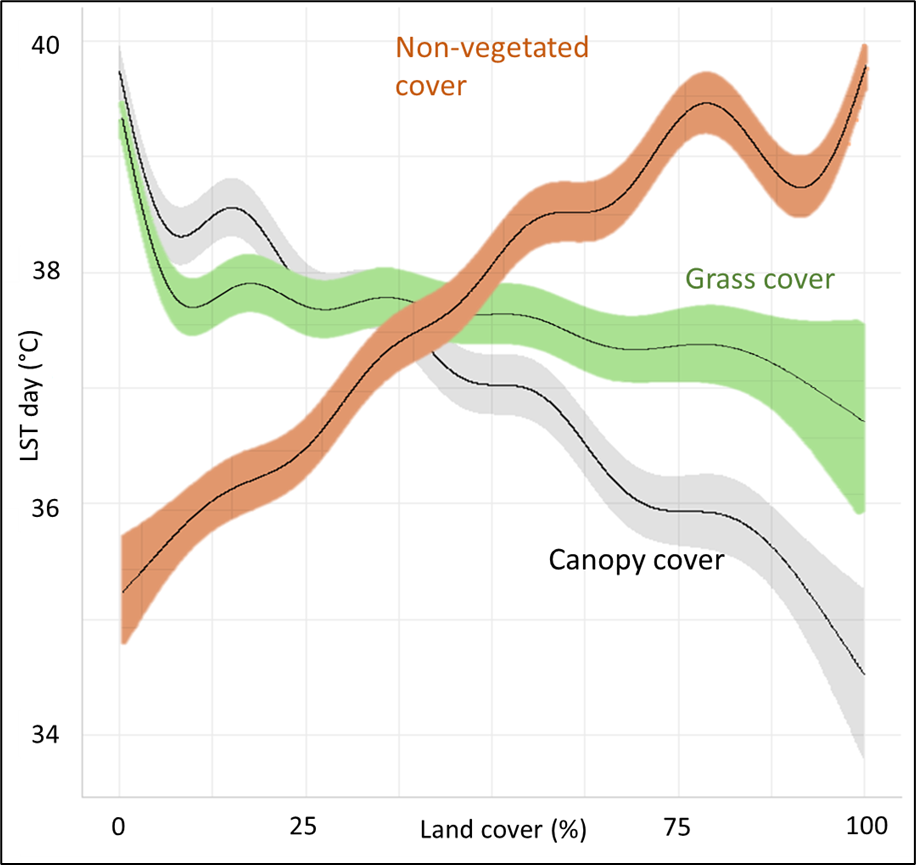Example of new (top) and old (bottom) developments in Penrith, NSW (caption and credits below)
Authors: Alessandro Ossola and Michelle Leishman, September 26th, 2021
For decades the humble residential yard has been part of the quintessential Great Australian Dream – home ownership. Fast forward to modern days, this dream has largely forgotten our much-loved front and backyards. Houses have become bulkier and larger while block size has shrunk, resulting in small yards with minimal plants and vegetation. During extremely hot summer days, the dream even turns into a scorching nightmare in densely built suburbs. As put by Tony Hall’s book Life and Death of the Australian Backyard, “the scale and timing of this change has been little short than dramatic”.
Despite this change, residential yards – the largest type of urban green space in many cities and towns in the western world – can have a dramatic and collective impact on how urban forests and vegetation are designed and planted, and in turn how we can reap greening benefits for people and communities. Here we dive into some new research findings to discover how your own yard can make a significant contribution to urban cooling, hopefully making the case to the jury for “saving the yards and their trees!”.
The great Aussie backyard comes to the rescue mitigating urban heat
In collaboration with AdaptWest in western Adelaide, SA, and the Cities of West Torrens, Charles Sturt, and Port Adelaide – Enfield, we conducted a study to measure the contribution of urban green spaces to reducing urban heat during an extreme summer heatwave (Ossola et al., 2020 and 2021 for the full report and scientific paper).
Across 90 suburbs in the three Local Government Areas, we found that the ~145,000 front-, corner- and backyards (excluding the building footprints) covered more than 18% of urban land, almost double the amount covered by open space (10%). However, when considering tree and grass cover, residential yards contained more than 48% of the entire urban forest cover and more than 31% of all lawns and grassy areas in western Adelaide. In comparison, urban parks contained only 15% and 28% of Adelaide’s tree canopy and herbaceous cover. Not bad for our private greenspaces, is it?

Figure 1: Research on Western Adelaide’s yards suggests that suburbs (black points) with greater front- and backyard area have significantly greater tree canopy cover (Ossola et al., 2020).
In this research we also found that suburbs with higher residential yard cover also had higher tree canopy cover (Fig. 1). Suburbs with more than 15% backyard cover and 10% front yard cover reached 15-20% canopy cover in residential land (i.e., excluding streetscapes and parks).
It seems apparent that if local governments across Australia want to achieve ambitious canopy cover targets in their urban forest strategies, the inclusion of yards and private greenspaces is a much-needed opportunity due to their large expanse, the large amount of vegetation they host and opportunities for further plantings.

Figure 2: Models linking decreases in land surface temperature (LST) during a heatwave in Adelaide, SA, with increments in grass and canopy cover. Increases in non-vegetated land covers, such as buildings and impervious surfaces, greatly increase urban heat and particularly during extreme heat events. In Adelaide most of the tree cover is located in private properties and yards, making them the largest contributors to urban cooling (Ossola et al., 2020, 2021).
When measuring land surface temperature (LST) during the heatwave tracked in 2017 (Ossola et al., 2020), we also found that greening non-vegetated areas, such as impervious pavements, with full tree canopies (i.e., 100% canopy cover) could result in significant reductions in LST during daytime of up to 5-6°C. Even by using grasses and turf we can have more moderate yet important benefits of 2-3°C LST reductions (Fig. 2).
As most trees and a large amount of grasses are contained in our yards, these provide an extremely important and irreplaceable thermal cooling benefit to our cities and towns. Last night I dreamt about freeing our yards from concrete and turning them into cool urban oases.
Can you help us in making this green dream come true?
Banner image: Example of new (top) and old (bottom) developments in Penrith, NSW with newer dwellings having a significantly smaller yard area than older ones and consequently much lower canopy cover and available planting space. Penrith was the hottest place on Earth on Jan 4th 2020 reaching 48.9°C during daytime. Image courtesy: Google Earth 2018.
REFERENCES
Hall, T., 2010. The Life and Death of the Australian Backyard. CSIRO Publishing. https://www.publish.csiro.au/book/6449/
Ossola, A., Locke, D., Lin, B, Minor, E., 2019. Greening in style: Urban form, architecture and the structure of front and backyard vegetation. Landscape and Urban Planning, 185, 141-157. https://doi.org/10.1016/j.landurbplan.2019.02.014
Ossola, A., Staas, L., Leishman, M, 2020. Urban trees and people’s yards mitigate extreme heat in western Adelaide: final summary report. https://doi.org/10.25949/5df2ef1637124.
Ossola, A., Jenerette, D., McGrawth, A., Chow, W., Hughes, L., Leishman, M.L., 2021. Small vegetated patches greatly reduce urban surface temperature during a summer heatwave in Adelaide, Australia. Landscape and Urban Planning, 209, 104046. https://doi.org/10.1016/j.landurbplan.2021.104046

